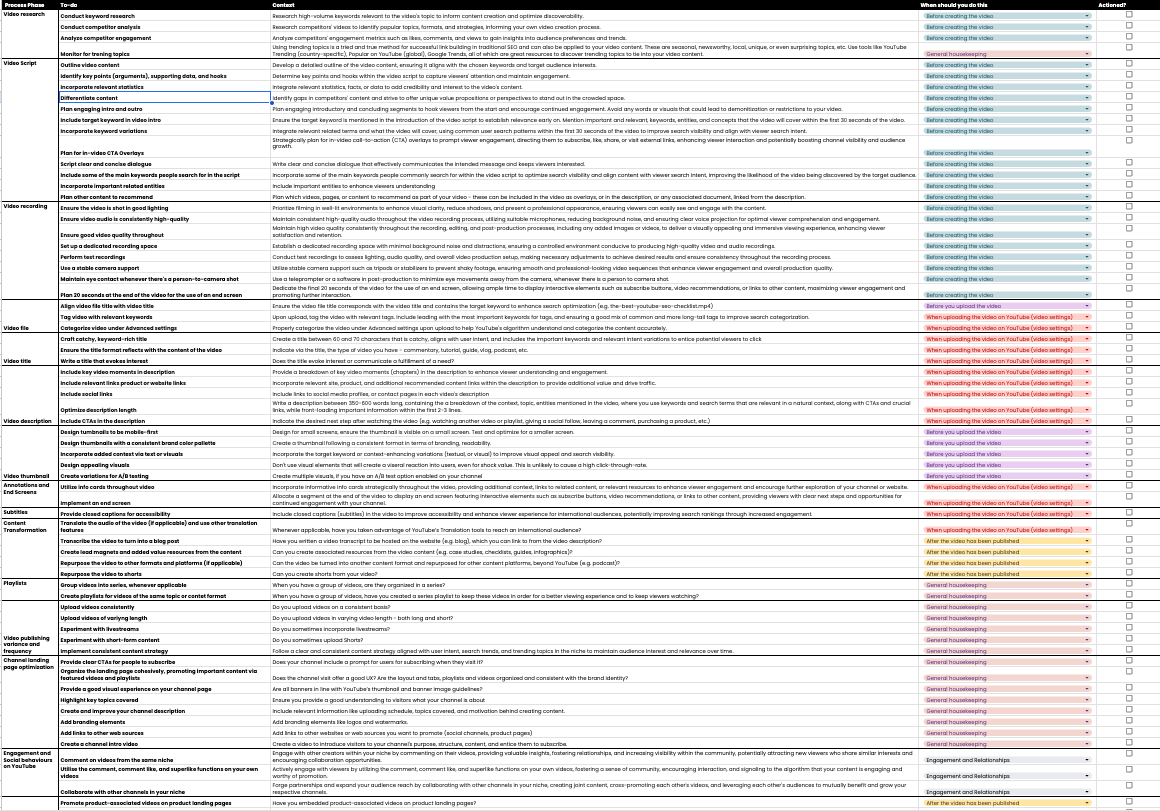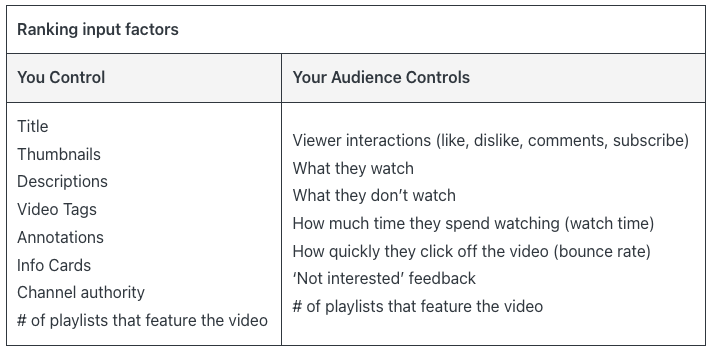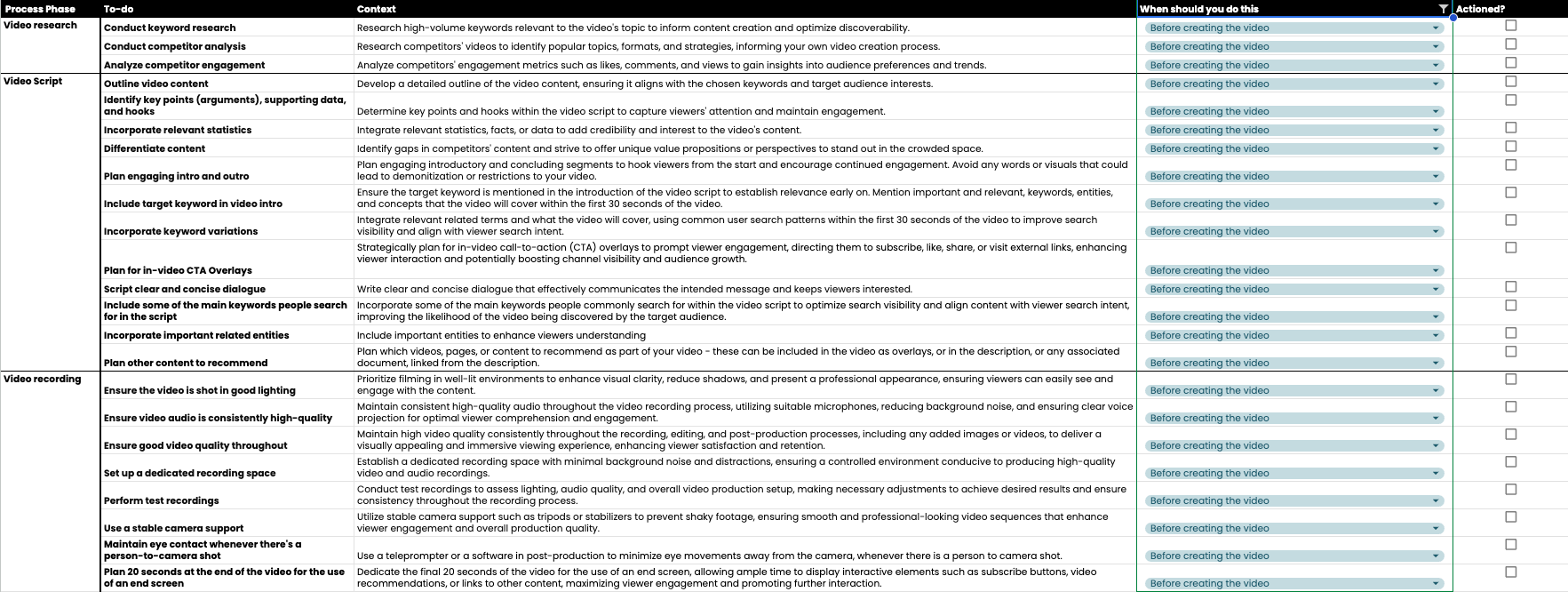Okay, you have completed a YouTube SEO audit, and identified that your channel and videos can do with a bit of a facelift. With billions of users and hours of content uploaded every minute, standing out might seem impossible. Yet, it’s more achievable than you think.
In the following post, I’ll go through the main areas, that you can do on autopilot to improve your YouTube SEO, and in turn – boost your organic visibility, on the platform and off it! My aim with this post (and the associated free checklist) is to enable you to set appropriate systems to make the most out of your content and create good quality, SEO-friendly videos by default, leaving time to focus on what really matters for your YouTube channel to thrive – content and substance!
the ultimate checklist
YouTube SEO checklist
70+ steps to help boost the search visibility of your videos

Why is YouTube SEO important for businesses and content creators
There are several factors that are making YouTube ever-so-important for companies, service providers, freelancers, educations, and entertainment creators:
- Diversifying the Google SERP to feature more video content: Google is moving towards featuring more diverse content in the SERP, which includes video.
- Monetisation and a chance to get yourself in front of a pretty sizeable audience: YouTube is at war with TikTok and is pouring money in user retention and platform growth to sustain ad revenue.
- Get recommended: Creating high-quality videos that get noticed by YouTube’s algorithms, appear in search results, suggestions, and even the homepage.
- Visibility boost: Reaching the right audience with relevant keywords leads to more likes, comments, and shares, pushing your video further.
- Targeted audience: Having a strategy behind your uploads and building a topical authority on the platform, combined with publishing high-quality videos can attract viewers genuinely interested in your content, boosting watch times and subscribers
- Search behaviours are changing: Whether you like it or not, people are using YouTube Search and TikTok Search (a.k.a. their preferred platform for entertainment and education) to search instead of using Google Search. They might use both, or either. In which case, doesn’t it sound ever so important for you to be there, just in case they don’t jump to Google? That’s how I see it anyway.
What is YouTube’s search algorithm and how does it work
Mastering the algorithm is key to YouTube success. It ranks videos based on factors like content relevance, user engagement, video quality, content freshness, and overall satisfaction. These are all highly niche-dependent, and success in either of these fields will vary per niche, type of videos created, topics covered, and so on.

Generally, however, there are some evergreen principles of YouTube SEO that will be exactly the topic of the rest of this article (and the checklist), that fall mostly into one of these factors:
- Research: Find what your audience searches for and use those keywords strategically. Incorporate associated entity information, and stay within the same topic and/or content format niche with the channel you create.
- Engaging, high-quality content: Create videos that keep viewers glued and encourage interaction.
- Consistency: Regularly upload valuable content to enable the algorithm to recommend your channel to more people.
- Analytics: Track your performance and adjust your strategy based on data.
By understanding and setting systems to address some of these aspects of YouTube content publishing, you can reach your target audience and achieve success on YouTube.
How important is YouTube SEO
Whether you want to believe it, or not – some people use YouTube as a search engine, so implementing search engine optimization tactics can undoubtedly help you stand out.
YouTube matters:
- Second largest search engine: Use it to improve your brand omnipresence.
- Quicker indexing: Indexing on YouTube, and subsequently in Google Search’s video tab is from my experience quicker, with the proper linking between videos and web pages, this might be a great way to improve indexing rates
- More views, engagement, and subscribers: Optimised videos get noticed, leading to growth, which can, with the appropriate linking between videos and product/service pages, lead to new customers, too.
- Understand your audience: Reach the right people, answer their questions uniquely.
SEO is ongoing, not a one-time fix. While the platform and its associated best practices change, we will discuss some evergreen tactics from traditional web-based SEO, and how they translate to YouTube SEO, as well as discuss how to best use features that are unique to YouTube.
Tips and strategies for improving your YouTube SEO
Before you create your YouTube video focus on Video Research, Scripting and Production
There are essentially three phases you will have before you even have a video file ready – video research, scripting and production. For each of these phases I will share various tactics to incorporate SEO practices.
When it comes to video research, here are some elements to consider before publishing a video:
- Conduct keyword research: Research high-volume keywords relevant to the video’s topic to inform content creation and optimize discoverability.
- Conduct competitor analysis: Research competitors’ videos to identify popular topics, formats, and strategies, informing your own video creation process.
- Analyze competitor engagement: Analyze competitors’ engagement metrics such as likes, comments, and views to gain insights into audience preferences and trends.
When scripting your video, consider the following aspects:
- Outline & Hooks: Create a detailed outline, identify key points & hooks, and sprinkle relevant statistics.
- Differentiation: Stand out by offering unique value and avoiding copied content.
- Engaging Intro/Outro: Hook viewers from the start and encourage interaction. Mention target keyword within 30 seconds.
- CTA Overlays: Strategically use CTAs to prompt subscriptions, likes, shares, and clicks.
- Clear & Concise: Write engaging dialogue that keeps viewers glued.
- Include search keywords, and related entities: Include main keywords naturally throughout the script. Enhance understanding by featuring relevant entities.
- Content Recommendations: Plan videos, pages, or content to recommend for further engagement.
Remember: Avoid demonitizable content, visuals, or words, especially early-on in the video, but also throughout, and plan CTAs and promotions within legal boundaries.
When you are ready to record the video, think about these aspects as they can also impact your video’s reach:
- Ensure the video is shot in good lighting: Prioritize filming in well-lit environments to enhance visual clarity, reduce shadows, and present a professional appearance, ensuring viewers can easily see and engage with the content.
- Ensure video audio is consistently high-quality: Maintain consistent high-quality audio throughout the video recording process, utilizing suitable microphones, reducing background noise, and ensuring clear voice projection for optimal viewer comprehension and engagement.
- Ensure good video quality throughout: Maintain high video quality consistently throughout the recording, editing, and post-production processes, including any added images or videos, to deliver a visually appealing and immersive viewing experience, enhancing viewer satisfaction and retention.
- Set up a dedicated recording space: Establish a dedicated recording space with minimal background noise and distractions, ensuring a controlled environment conducive to producing high-quality video and audio recordings.
- Perform test recordings: Conduct test recordings to assess lighting, audio quality, and overall video production setup, making necessary adjustments to achieve desired results and ensure consistency throughout the recording process.
- Use a stable camera support: Utilize stable camera support such as tripods or stabilizers to prevent shaky footage, ensuring smooth and professional-looking video sequences that enhance viewer engagement and overall production quality.
- Maintain eye contact whenever there’s a person-to-camera shot: Use a teleprompter or a software in post-production (e.g. the eye-contact function of Descript video editor) to minimize eye movements away from the camera, whenever there is a person to camera shot.
- Plan 20 seconds at the end of the video for the use of an end screen: Dedicate the final 20 seconds of the video for the use of an end screen, allowing ample time to display interactive elements such as subscribe buttons, video recommendations, or links to other content, maximizing viewer engagement and promoting further interaction.

Before you upload the video to YouTube optimize the video file and thumbnail
Before uploading your video to YouTube, title the video file descriptively and create an enticing and search-friendly thumbnail.
Regarding the thumbnail, take note of the following best practices:
- Design tumbnails to be mobile-first: Design for small screens, ensure the thumbnail is visible on a small screen. Test and optimize for a smaller screen.
- Design thumbnails with a consistent brand color pallette: Create a thumbnail following a consistent format in terms of branding, readability.
- Incorporate added context via text or visuals: Incorporate the target keyword or context-enhancing variations (textual, or visual) to improve visual appeal and search visibility.
- Design appealing visuals: Don’t use visual elements that will create a viseral reaction into users, even for shock value. This is unlikely to cause a high click-through-rate.
- Create variations for A/B testing: Create multiple visuals, if you have an A/B test option enabled on your channel

When you are uploading your video to YouTube implement a thorough process of title, description optimization and feature utilization
When you are uploading your video to YouTube, there are a number of features to take advantage of that can help improve your visibility on the platform. Mainly, focus on improving the title and description, but don’t neglect aspects like info cards, end screens, tags, subtitles, and other extra features (if you’re eligible).
Here are some SEO aspects to consider when writing your YouTube video title:
- Craft catchy, keyword-rich title: Create a title between 60 and 70 characters that is catchy, aligns with user intent, and includes the important keywords and relevant intent variations to entice potential viewers to click
- Ensure the title format reflects with the content of the video: Indicate via the title, the type of video you have – commentary, tutorial, guide, vlog, podcast, etc.
- Write a title that evokes interest: Does the title evoke interest or communicate a fulfillment of a need?
When writing a video description for your YouTube video, don’t forget to:
- Include key video moments in description: Provide a breakdown of key video moments (chapters) in the description to enhance viewer understanding and engagement.
- Include relevant links product or website links: Incorporate relevant site, product, and additional recommended content links within the description to provide additional value and drive traffic.
- Include social links: Include links to social media profiles, or contact pages in each video’s description
- Optimize description length: Write a description between 350-600 words long, containing the a breakdown of the context, topic, entities mentioned in the video, where you use keywords and search terms that are relevant in a natural context, along with CTAs and crucial links, while front-loading important information within the first 2-3 lines.
- Include CTAs in the description: Indicate the desired next step after watching the video (e.g. watching another video or playlist, giving a social follow, leaving a comment, purchasing a product, etc.)
Don’t forget to tag your video, and indicate a category for it, as well as upload subtitles. Use the info cards to recommend other content from your channel, or if you’re eligible, other external content that’s relevant to the viewer (e.g. product pages or blog posts). Choose and implement your end screen design at this stage, too.

After you upload your video to YouTube, focus on content transformation and video promotion
After your video has been published, schedule in some time for content transformation and video promotion.
Regarding content transformation, here are some ideas to make your content work harder for your organic visibility:
- Transcribe the video to turn into a blog post: Have you written a video transcript to be hosted on the website (e.g. blog), which you can link to from the video description?
- Create lead magnets and added value resources from the content: Can you create associated resources from the video content (e.g. case studies, checklists, guides, infographics)?
- Repurpose the video to other formats and platforms (if applicable): Can the video be turned into another content format and repurposed for other content platforms, beyond YouTube (e.g. podcast)?
- Repurpose the video to shorts: Can you create shorts from your video?
Regarding promotion, initiate the following tasks:
- Promote product-associated videos on product landing pages: Have you embedded product-associated videos on product landing pages?
- Feature your videos in blogs: Promote YouTube videos in associated blog posts on your website and tag them with the appropriate structured data
- Promote the video in communities of interest: Reach out to site owners and in various communities to get your video featured on other websites, and in other videos on YouTube.

Evergreen tactics for YouTube organic visibility and a good user experience on your channel
Here are some additional tips to making sure your YouTube channel is set up for growth:
- Monitor and incorporate trending topics into your content strategy
- Regularly comment on other creators’ videos, and engage with your own comments section
- Utilize the community tab to share updates, related to your channel, post photos, or post polls
- Collaborate with other channels in your niche
- Optimize your channel landing page’s user experience by adding a description, and associated links to webpages and social, clear organization of videos within playlists or per topic or content type, and maintaining a consistent and professional branding in the logo, and other visual elements
- Upload videos consistently, and experiment with different video formats and length

Key takeaways on YouTube SEO
Mastering YouTube SEO is a strategic investment that unlocks visibility, engagement, and growth for your channel.
Key takeaways and high-level YouTube SEO tips to follow:
- Optimise for search: Use relevant keywords in titles, descriptions, and tags.
- Boost visibility: Optimize titles, descriptions, and tags with relevant keywords to help viewers find your content.
- Aim for retention: Hook viewers and keep them watching.
- Engage your audience: Create high-quality content that entices viewer interactions (likes, comments, shares).
- Prioritise viewer experience: Focus on relevance, engagement, and satisfaction.
- Track and adapt: Use analytics to understand what works and refine your SEO strategy for better rankings and growth.
- Stay ahead of the curve: Keep up with YouTube’s evolving algorithm to ensure long-term visibility and success.
- Continuous optimization: Stay updated with new content trends, video production techniques, and adapt to algorithm changes.
By following these steps and consistently optimizing your content, you’ll attract the right audience and propel your channel towards success. Remember, SEO is a journey, not a destination. Embrace the learning process, refine your approach, and watch your channel flourish.
Frequently Asked Questions on YouTube SEO
Why is YouTube SEO important for content creators?
YouTube SEO is crucial for visibility, engagement, and growth. It helps your videos appear in search results, suggested lists, and the homepage, increasing your chances of reaching a wider audience. Proper optimization signals to YouTube that your content is valuable, enhancing your video’s reach and engagement.
How does optimizing videos for YouTube affect audience targeting?
Optimizing videos with the right keywords, tags, and descriptions aids in accurately targeting your audience. It ensures that your content reaches viewers actively searching for topics you cover, improving the likelihood of engagement and subscription.
What factors does YouTube’s search algorithm consider?
YouTube’s algorithm prioritizes relevance, engagement, quality, freshness, and viewer satisfaction. Videos that perform well on these fronts are more likely to be recommended, appearing in search results and suggested video lists, enhancing visibility and audience reach.
How can keywords improve my YouTube video ranking?
Incorporating relevant keywords in your video’s title, description, and tags helps YouTube understand the content and context of your video. This improves the chances of your video being discovered by viewers searching for those topics, thereby increasing visibility and rankings.
What role does viewer engagement play in YouTube SEO?
Viewer engagement, including likes, comments, and shares, signals to YouTube that viewers find your content valuable. High engagement rates can boost your video’s visibility in search results and suggested feeds, leading to increased watch time and subscriber growth.
Why is monitoring YouTube analytics important for SEO?
Monitoring YouTube analytics is essential to understand the performance of your SEO strategy. Key metrics like video rankings, watch time, retention rates, and traffic sources provide insights into what’s working and what needs improvement, allowing you to refine your strategy for better results.
Is YouTube SEO a one-time task?
No, YouTube SEO is an ongoing process. The digital landscape and viewer preferences constantly evolve, so it’s important to continuously analyze and optimize your videos (learn how to do a YouTube SEO audit with this step-by-step guide). Regular updates to keywords, titles, descriptions, and content based on analytics insights are crucial for sustained growth and audience engagement.
